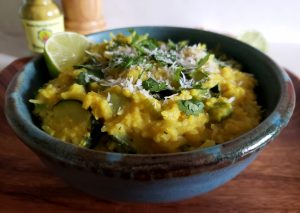 Just because summer is approaching doesn’t mean that you have to say goodbye to your kitchari (whew!). In fact kitchari is such a balanced, nourishing meal that it is often recommended to be eaten as a dietary staple all year round! Luckily kitchari is so versatile we can easily make it using seasonal appropriate spices, veggies, and oils to allow their properties to keep us in balance no matter what time of year it may be. This particular kitchari recipe is perfect for the late spring, summer, and early fall seasons; or basically any time your Pitta is out of whack!
Just because summer is approaching doesn’t mean that you have to say goodbye to your kitchari (whew!). In fact kitchari is such a balanced, nourishing meal that it is often recommended to be eaten as a dietary staple all year round! Luckily kitchari is so versatile we can easily make it using seasonal appropriate spices, veggies, and oils to allow their properties to keep us in balance no matter what time of year it may be. This particular kitchari recipe is perfect for the late spring, summer, and early fall seasons; or basically any time your Pitta is out of whack!
Pitta is the dosha type that is manifested mainly from the fire (and secondary water) element. Some common signs and symptoms of increased Pitta would be issues such as skin disorders (eczema, psoriasis, etc), acne, hives, rash, inflammation (any and all types), anger, judgement, criticism, jealousy, hyperacidity, heartburn, H. pylori, loose stools, diarrhea, and any inflammatory GI tract issue including Crohn’s, colitis, gastritis, ulceration, diverticulitis and IBS. If you are experiencing any of these symptoms, this kitchari recipe will be a beneficial meal to help bring balance back to the system and heal the disorder.
So what exactly makes this recipe so specific for reducing Pitta? The mung dal (split mung bean) and basmati rice are cooling by nature and possess a mild sweetness that is great for calming down Pitta and the excessive heat it brings. Coconut oil and ghee are very cooling and anti-inflammatory, as is the cumin seed, cilantro, lime, and shredded coconut. Pitta Churna is used to reduce Pitta digestive imbalances (hyperacidity, IBS, colitis, etc) and although it will strengthen the digestive fire, this blend does so without creating further heat in the system. Finally the vegetables chosen for this recipe are all hydrating, cooling, cleansing, and hence calming for Pitta types. Kale and celery are specific for cooling and cleansing the liver and blood, which tend to be common issues in many high Pitta conditions. Asparagus is a close relative of the Pitta-reducing herb Shatavari and therefore possesses similar healing properties such as being cooling, soothing, and an excellent rejuvenator (especially for the reproductive system!).
Health benefits of Pitta-Reducing Kitchari
- Reduces overall Pitta in the body and mind
- Easy to digest
- Strengthens and balances the Agni (digestive fire)
- Cools and cleanses the liver and blood
- Reduces inflammation
- Beneficial in most Pitta disorders such as skin disorders, acne, hives, rash, inflammation, arthritis, anger, judgement, criticism, hyperacidity, loose stools, diarrhea and inflammatory GI tract issues
- Great recipe option for Pitta types during Ayurvedic cleanses
- Great recipe option during the late spring, summer and early fall seasons (but can be enjoyed all year round for Pitta types and during Pitta imbalance)
Pitta-Reducing Kitchari
Click here for a printable copy of this recipe.
- Doshic effect: Vata ↓, Pitta ↓, Kapha ↓↑*
- Serves: 5 to 6
- Prep Time: 5 to 10 minutes
- Cook Time: 35 minutes
*Although this recipe is suitable for all dosha types, it is best for Pitta and may increase Kapha in excess. See the additional tips below the recipe to make it a bit more Kapha pacifying.
Materials
- Large sauce pan
- Measuring spoons and cups
- Cutting board and knife
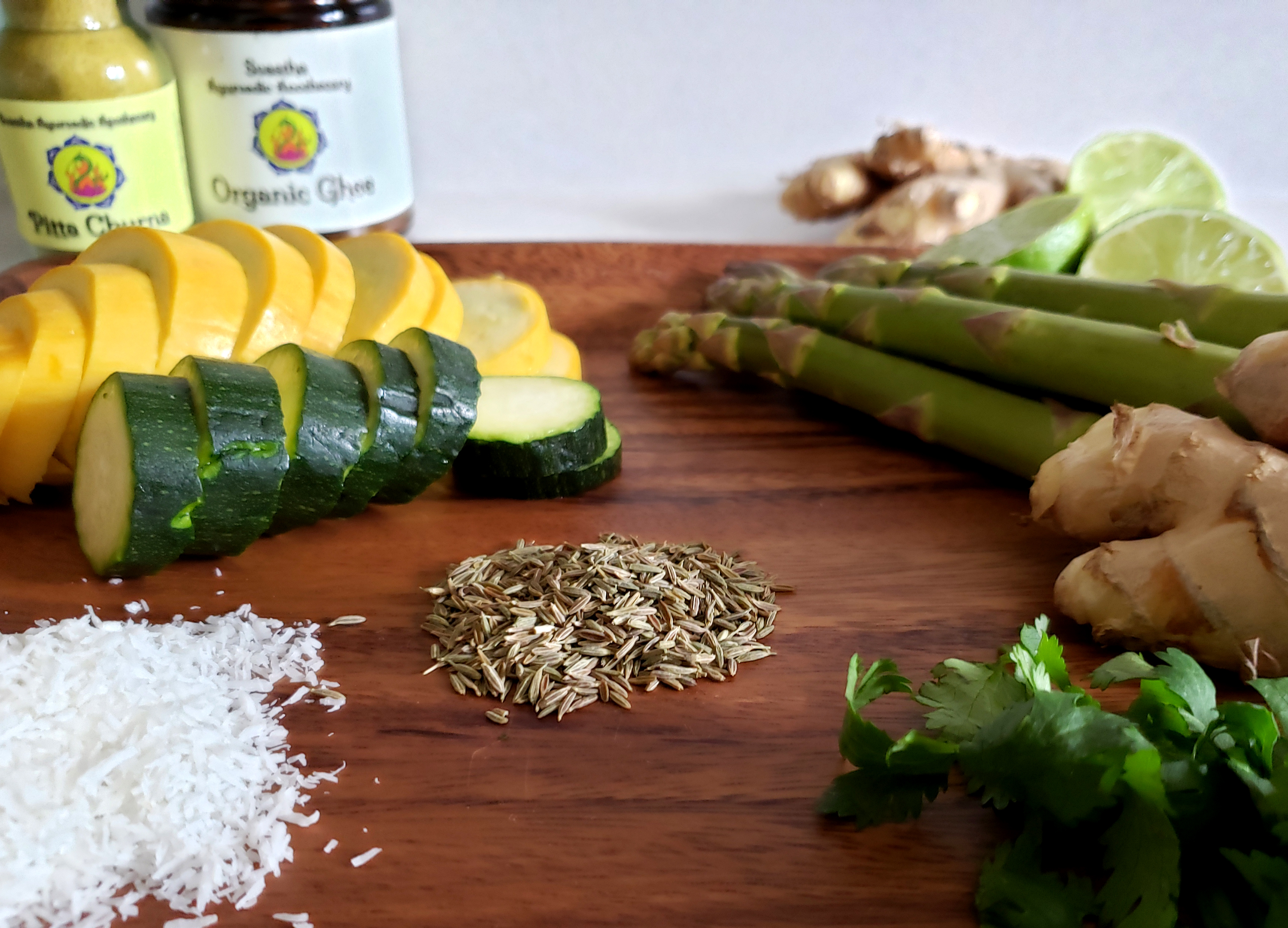
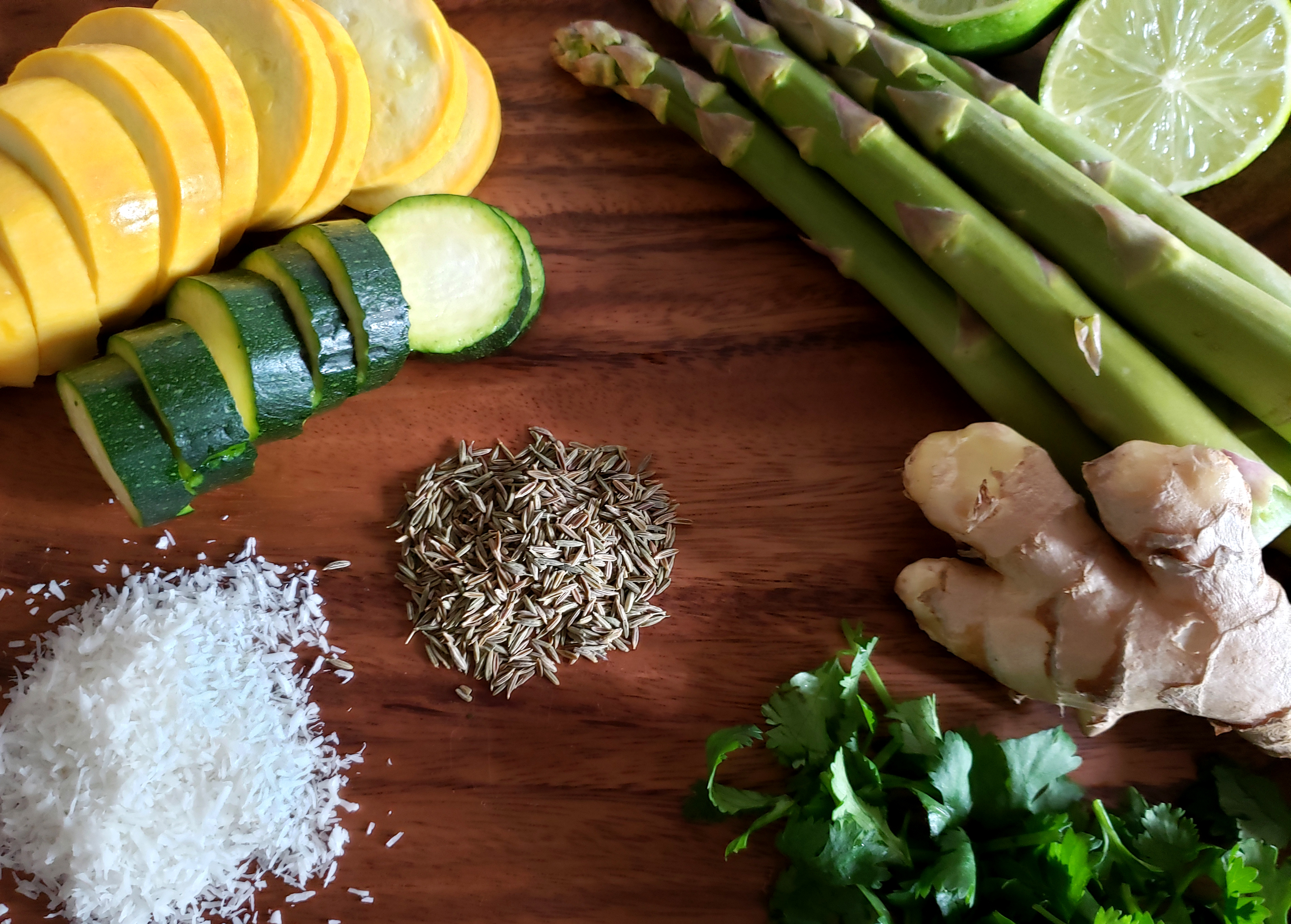
Ingredients
- 1 teaspoon cumin seed, whole
- 1/8 teaspoon freshly ground black pepper
- 1 1/2 teaspoons Pitta Churna*
- 2 tablespoons finely minced ginger
- 2 tablespoons ghee
- 2 tablespoons shredded coconut
- 6 cups water
- 1 cup mung dal
- 3/4 cup basmati rice
- 1/2 cup chopped zucchini
- 1/2 cup chopped yellow squash
- 5 asparagus stalks, chopped
- 1 large celery stick, thinly sliced
- 1 large kale, stemmed and thinly sliced
- 1/2 cup of fresh cilantro, finely chopped
- 1 lime, juiced
- 1/2 teaspoon pink Himalayan salt
- Chopped cilantro, for garnish
- Shredded coconut, for garnish
- Ghee, for individual servings
*Pitta Churna can be replaced with Agni Churna or a mixture of 1/2 tsp turmeric, 1/2 tsp cumin powder, 1/4 tsp coriander powder, 1/4 tsp fennel powder and a pinch of cardamom.
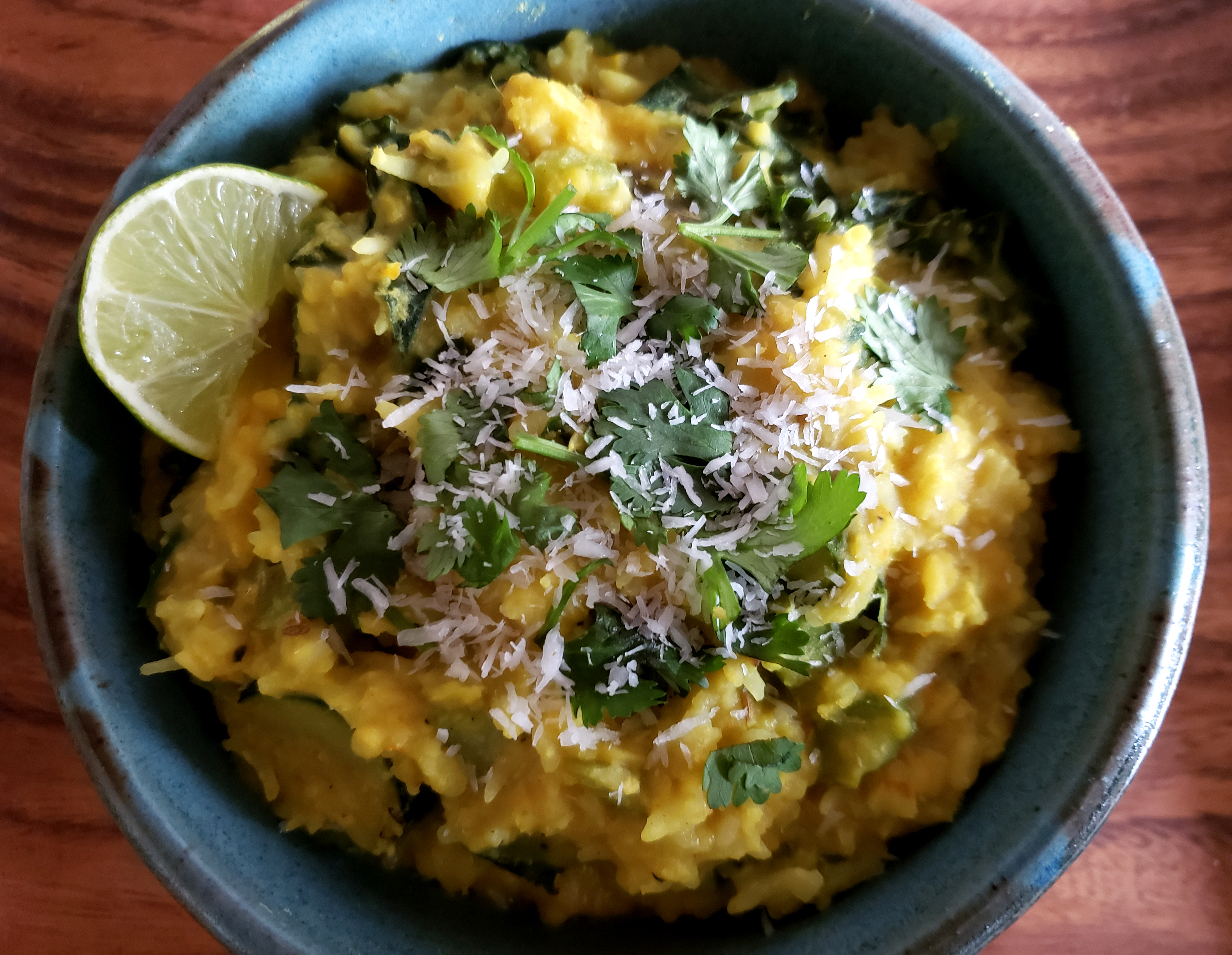
Click here for a printable copy of this recipe.
Directions
1. Heat a large sauce pan over medium heat and add the ghee. Once hot, add in the cumin seed and black pepper. Sauté here for 2 minutes stirring frequently.
2. Add in the Pitta Churna, fresh ginger, and shredded coconut. Stirring constantly, sauté for an additional 30 seconds.
3. Pour the water into the pan and bring it to a boil.
4. Add the mung dal and reduce the heat to medium. Cover the pan, leaving a crack to prevent overflow. Cook here for 15 minutes, stirring every 5 minutes.
5. As the beans are cooking, begin to chop the zucchini, yellow squash, celery, asparagus, and kale.
6. After the 15 minutes is up, add in the rice, zucchini, yellow squash, celery, asparagus, and kale to the pan. Stir well and place the cover back onto the pot, leaving a small crack. Reduce the heat slightly to a low-medium setting and cook for 12 minutes.
7. Stir every 3 to 4 minutes during the remaining cooking time. If the kitchari becomes too thick, carefully add more water by the quarter cup.
8. After 12 minutes, turn the heat to low, cover the pan completely and cook for 3 additional minutes, stirring half way.
9. Turn off the heat and take the pan off of the hot burner. Add in the cilantro, fresh lime juice, and salt. Stir well and then cover for an additional 3 minutes to let all of the flavors soak in.
10. Once you are ready to serve, garnish each individual bowl with extra cilantro, shredded coconut, and ghee (about 1 tsp per bowl). Add any additional lime juice, salt, and pepper if needed.
11. Take a deep breath, sit comfortably in a peaceful space, and enjoy with good company!
Reheating tip: Kitchari is best the first day, however, it will keep for up to 3 to 5 days in the refrigerator. Since the ingredients tend to become dry after sitting overnight, it is recommended to add in 1/4 cup of water, 1 teaspoon of ghee, fresh lime juice, cilantro, shredded coconut, and a dash of salt and pepper with each reheated serving.
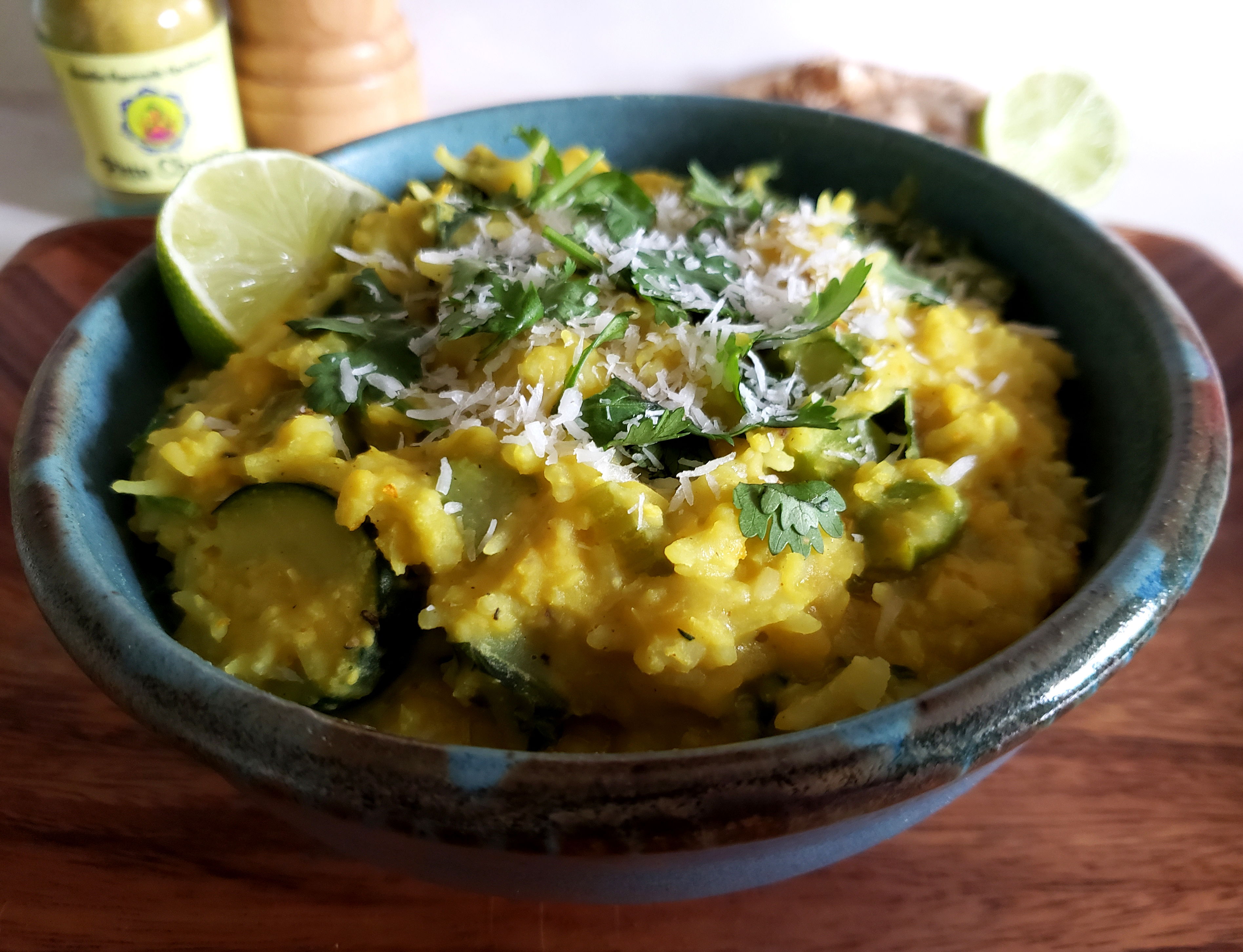
Additional Tips
- For even more gut healing, anti-inflammatory properties the water in this recipe can be replaced with bone broth.
- If you are using this recipe for a cleanse, it is recommended to omit the shredded coconut and increase the ghee, cilantro and lime juice in the recipe. The spices can also be increased as desired.
- If you are experiencing a simultaneous Kapha imbalance, this recipe can be adjusted to meet the needs of both Pitta and Kapha. For this, omit the shredded coconut (or cut it in half), replace the ghee with sunflower oil and replace the basmati rice with white quinoa. The spices used in this recipe should also be increased to help boost the sluggish digestive fire that Kapha is known for.
- If you are experiencing a simultaneous Vata imbalance, this recipe can be adjusted to meet the needs of both Pitta and Vata. For this, soak the mung dal overnight, straining and discarding the water before adding the beans to the recipe. Using bone broth or chicken broth in place of the water will also help to nourish Vata while still being beneficial for Pitta. The cooking time can be increased and the water or broth can be used generously to create a more soupy, well-cooked and mushy dish (all good qualities for Vata!). The spices, including the fresh ginger, can all be used generously.
Discover more healing recipes with my 30-Minute Ayurvedic Cookbook!

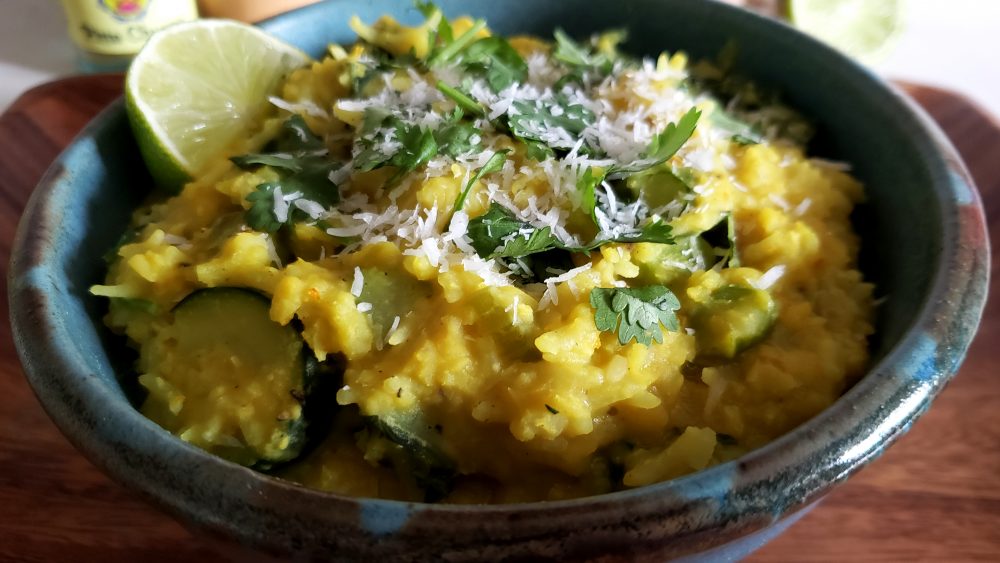
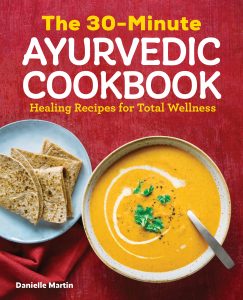

Thank you for this! Do you use white or brown basmati rice?
Hi Dina!
This recipe calls for white basmati rice, although you are welcome to use either. If you choose to use the brown rice of any variety, I would add it in at the same time as the mung dal to allow it to cook longer. The total time of cooking may increase, and the amount of water used will need to be increased as well. I am not sure the exact numbers off hand, so the best strategy will be to just keep an eye on it, taste as you go, and add more water as needed. Of course if you use the white basmati, the instructions can be kept as is. Please let me know if you have any further questions!
Namaste,
Danielle
Thank you for this, I am excited to try! Does the mung dal and/or rice need to soak prior to cooking?
Hi Kristin,
Thank you for your question! I suggest soaking the dal overnight in room temperature water, or when time is short, at least a couple hours in very hot water. The rice can be soaked as well, but if nothing else, rinse it with warm water to get the starchy powder off.
I hope you enjoy the recipe! Let me know if any further questions come up.
Be well:)
Namaste,
Danielle